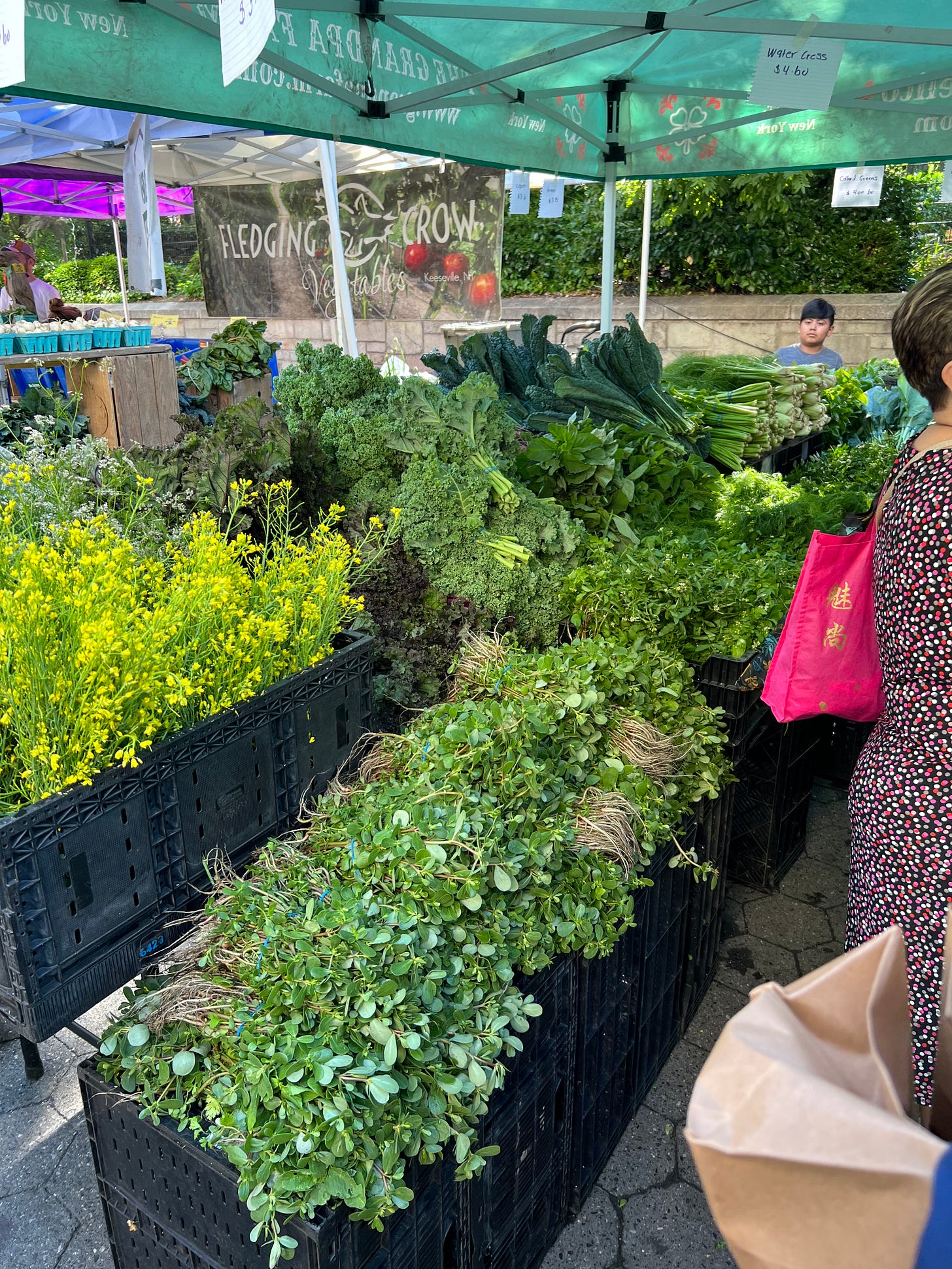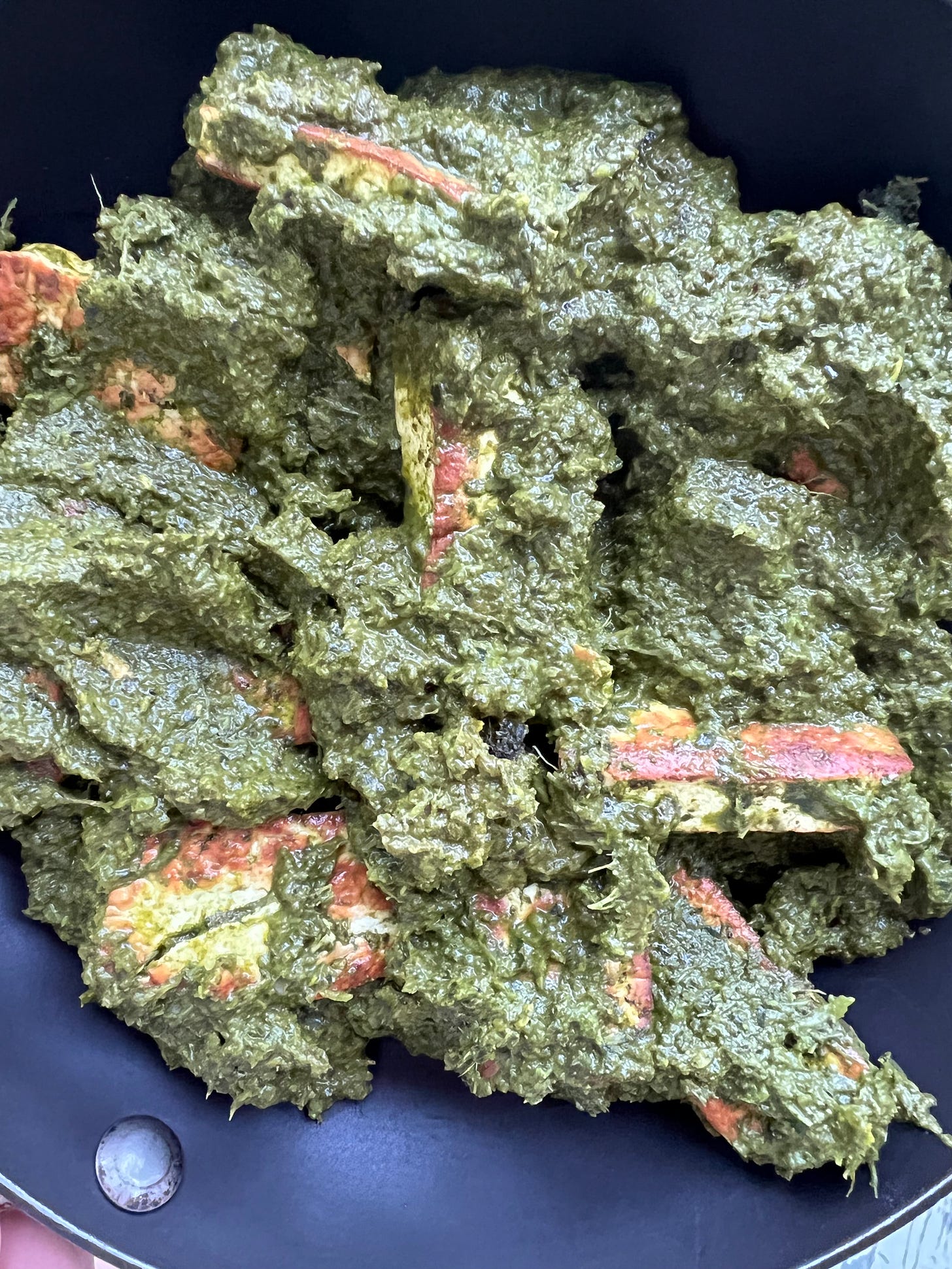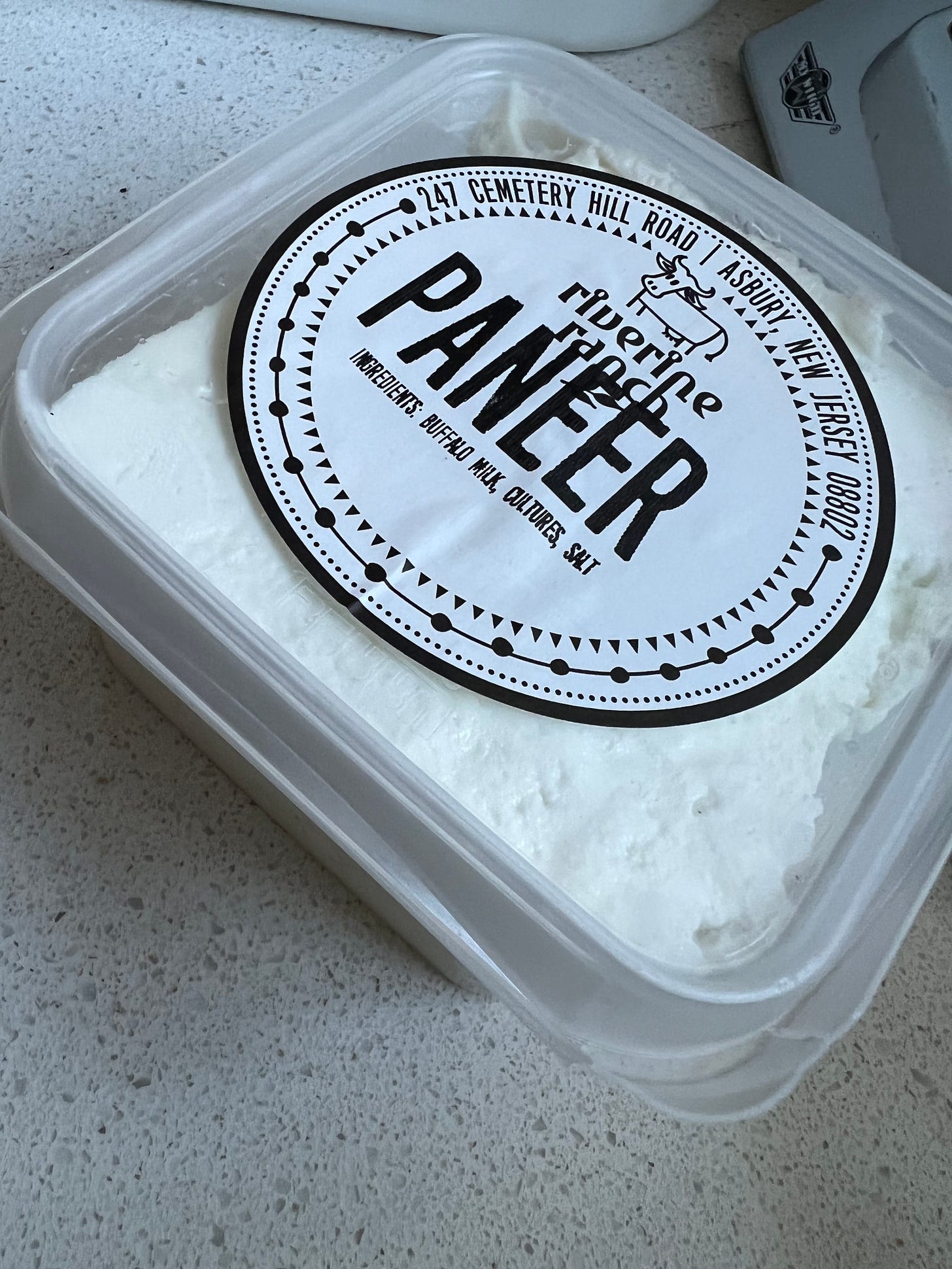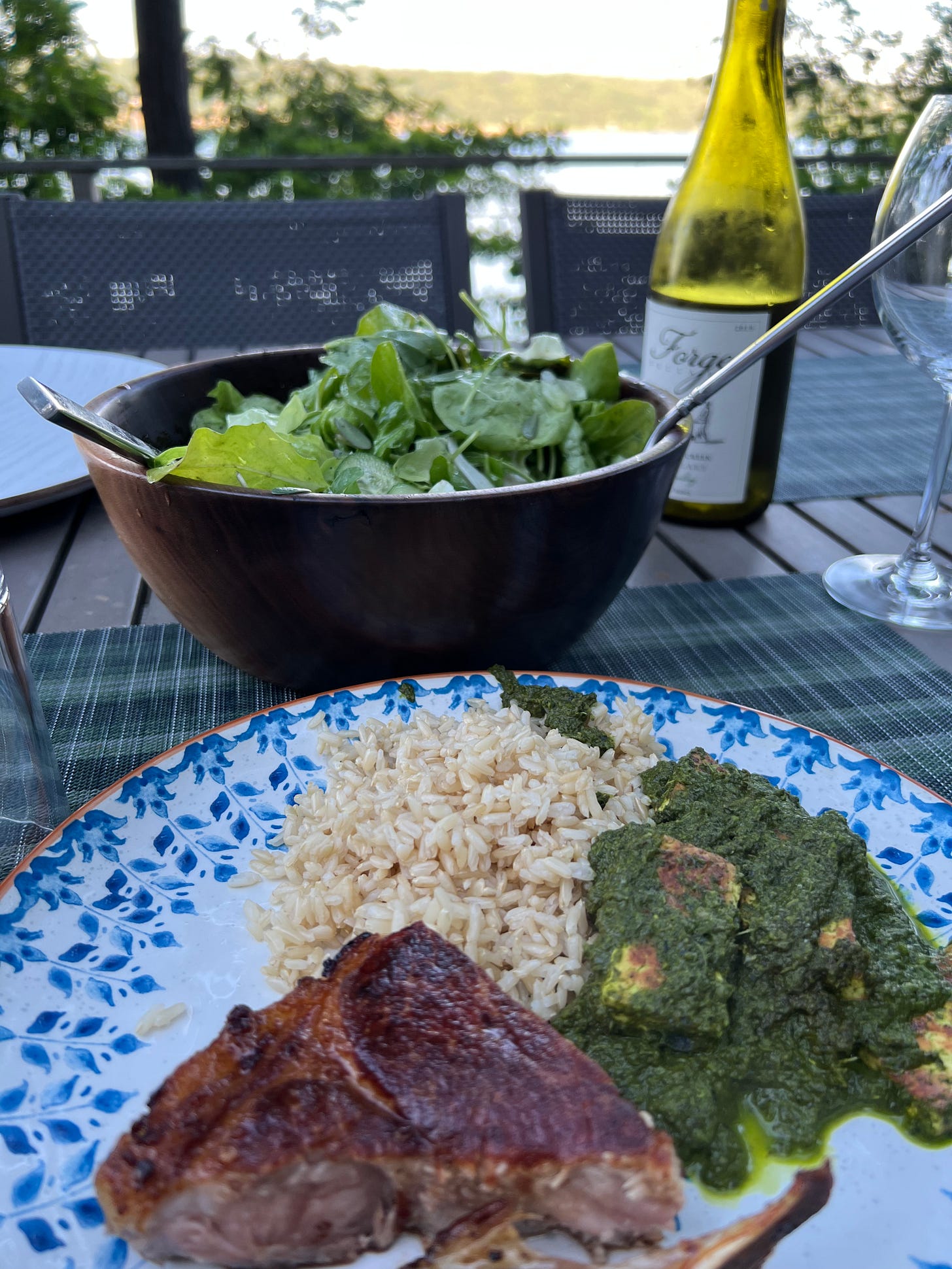Issue #57: Pining for Paneer
Eat Your Greens (and Don't Let Them Go To Waste), A Recipe for Saag Paneer
Another week, another newsletter. Farms in the northeast are in full swing and sometimes it’s hard for me to keep up with all the beautiful produce I see before me. I’ve been cooking and jamming like a maniac. That’s what led to today’s topic, a favorite dish and a favorite way to use up ingredients. But before we get there…
While you are cooking (or driving, or cleaning, or jogging, or doing whatever it is you do when you listen to podcasts), why not download the current episode of my podcast What’s Burning. This week Sam Kass, former chef and senior policy advisor to the Obamas, paints a global picture of the challenges facing the food system, including climate change and public health.. Click below to listen to the episode or find it wherever you get your podcasts. Thanks for your support. —Mitchell
Now, into the kitchen. As you know, I’m ever on the lookout for recipes that allow me to use a variety of different ingredients I might have lying around at any given time. Correction, that I do have lying around at any given time.
You could say I’m a bit of a hoarder when it comes to food shopping. Wherever I go—grocery stores, farmers markets, various countries—I just have to buy things I see that look, sound, smell, or taste intriguing. Whether an obscure seasoning or a beautiful head of lettuce, I have a hard time resisting. I get a bit of a thrill when I read a recipe and I already have everything I need to make it. Maybe hoarder isn’t the right word, though, because I don’t hang onto the things I purchase. I’m always looking for ways to use them, in part, so I can make room for whatever I might bring home next.

This is a time of year when the market is full of greens of many types: chards, kales, cresses, purslane, mustard greens, and spinach, to name a few. Tender tops of turnips, beets, radishes, and kohlrabi abound. Hardier leaves, like kale and cress, keep fresh for a while. But others have a shorter fridge life. Since it pains me to throw anything away, even wilted greens, I am constantly on the lookout for ways to cook them.
Luckily, there is saag paneer, an Indian dish of puréed greens with cheese that both my husband and I love. Nate loves it because he loves Indian food and Indian culture and cheese. I like all those things, too, but I also love that it is an excellent repository for whatever leafy vegetables you’ve got. As an added bonus, it is also a great way to use up excess cultured dairy products. More on that below.
Paneer is a fresh “cheese” made from straining and pressing acidulated milk. It has the unique quality of not melting when heated, so it holds its own when mixed with other things. Folks liken it, at least functionally if not how it’s produced, to halloumi, the sturdy, squeaky Cypriot cheese that you can grill, or even tofu. In fact many people suggest substituting firm, pressed tofu for paneer to make a vegan version of this dish.
In the case of saag paneer, the “other things” the paneer is mixed with is a spiced purée of greens. Although many think of saag paneer as typically made with spinach, technically with spinach what you have is palak paneer, palak being Hindi for “spinach.” Saag paneer can be made with any combination of greens, which might include spinach, but can also can include chard, mustard greens, kale, cresses, arugula, purslane, you know, things you might find at the greenmarket this time of year.
As for the dairy, here, too, you can take some license. Not all saag paneer recipes call for the addition of a substantial amount of dairy. But I like the creamy result of this approach. Yogurt, aka “curd,” is most traditional. But sour cream and/or crème fraiche make a delicious saag paneer, too. So do buttermilk, labne, and even heavy cream.
One final note. I cannot say this is the best saag paneer you’ve ever had because I haven’t tried them all. Yet. I can’t say it’s the most authentic, either. It certainly wasn’t in my New Jersey–born, Jewish grandmother’s repertory. But I know that it produces a delicious dish that I hope, like all the recipes I write about, you make it and it not only inspires you to cook more, but also to venture into other cuisines.

RECIPE: Saag Paneer
Makes 4 to 8 portions, depending on what else you are serving with it
Note: you can replace all the dry spices in the recipe below with a combination of 2 tablespoons of a favorite curry powder and an additional teaspoon of ground cumin.
About 20 ounces assorted greens, such as kale, chard, spinach, tops of turnips, beets or radishes, arugula, cresses, fenugreek leaves, pea shoots, fava leaves, or a combination
Salt
¾ pound (about 300 g) paneer
2 tablespoons ghee, butter, or vegetable oil
1 medium onion, sliced
3 cloves garlic, peeled and chopped
½-inch piece ginger, peeled and chopped
1 small green chili, seeded and chopped
2 teaspoons ground coriander
2 teaspoons ground cumin
1 teaspoon ground turmeric
1/2 teaspoon smoked paprika
¼ teaspoon ground black pepper
¼ teaspoon ground ginger
1/4 teaspoon ground kashmiri chili or cayenne pepper
1/4 teaspoon ground fenugreek or generous pinch dried fenugreek leaves (if not using fresh fenugreek leaves, which I haven’t found yet, in the mix of greens), optional
About 1 cup plain yogurt, full fat preferable, but sour cream, créme fraiche, labne, buttermilk, or other cultured dairy products will also work well
Juice of ½ lemon
Large handful chopped fresh cilantro
Remove any tough stalks, stems, and veins from the greens and rinse them well in a couple of changes of cold water. Bring a large pot with only 3 or 4 inches of water to a boil. Salt it generously. Add the prepared greens and blanch until soft, 1 or 3 minutes. Sturdier greens, such as kale and chard, will take a little longer. Drain, rinse in cold water and squeeze out any excess liquid. Coarsely chop and set aside.
Slice the paneer into rectangles about 1-by-1 ½ inches and ½ inch thick. Heat 1 tablespoon of the ghee in a nonstick pan over medium-high heat and fry the paneer rectangles until they are nicely browned on both sides, about 10 minutes total. Remove to a plate. Add the remaining butter to the pan and along with the onion, garlic, ginger, and chili and cook until the onion is soft and translucent, about 5 minutes. Add the coriander, cumin, turmeric, paprika, chili or cayenne, ground ginger, black pepper, and fenugreek, if using, and cook, stirring, until the spices are fragrant, about 1 minute. Add cooked, chopped greens to the pan, stirring to heat and through and thoroughly mix with the spices.
Transfer this mixture to a food processor or blender. Add some water to the pan to scrape out all the spices and add this to the processor or blender, as well. Also add about ¾ cup of the yogurt or other dairy products, and a generous pinch of salt. Process, pulsing the machine on/off, to create a creamy green paste. (If you prefer your saag paneer less smooth, hold back some of the greens and add them at the end.) Add more yogurt as needed to enable the mixture to purée. Transfer this mixture back to the pan and set over medium heat. Add the fried paneer and stir carefully, trying not to break up the paneer, until heated through and the paneer has softened somewhat. Taste and adjust the seasoning with additional salt and pepper. Depending on how tangy your yogurt is, you may want to add a squirt of fresh lemon to balance the flavor. Garnish with fresh cilantro and serve warm with basmati rice.





